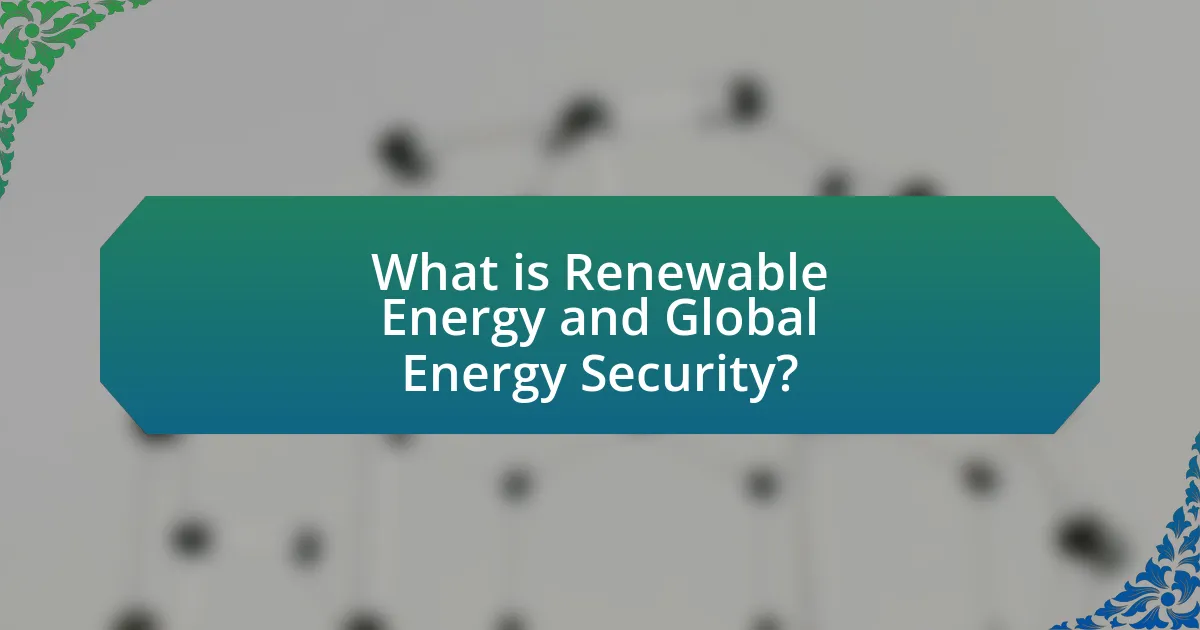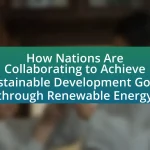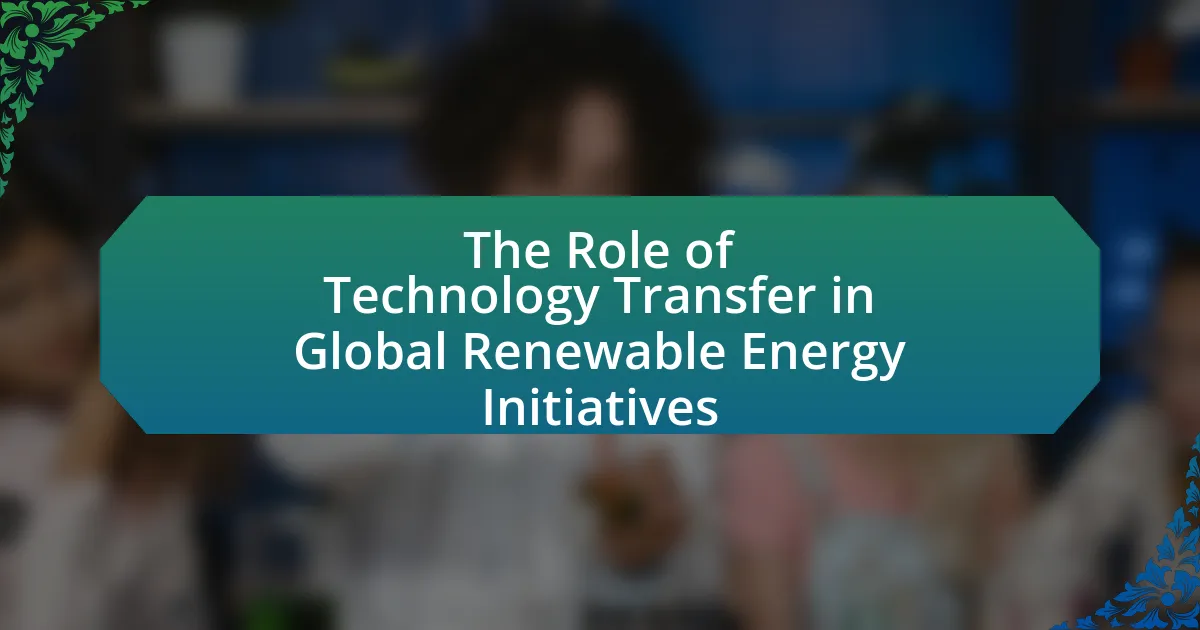Renewable energy, derived from natural sources that replenish quickly, plays a critical role in enhancing global energy security by diversifying energy supplies and reducing reliance on fossil fuels. This article examines how renewable sources such as solar and wind power contribute to energy independence, mitigate geopolitical risks, and address climate change. It discusses the types of renewable energy that are most impactful, the challenges and technological advancements in the transition to renewables, and the importance of supportive policies and international agreements. Additionally, it highlights the economic implications of this transition and future trends shaping renewable energy’s role in achieving sustainability goals.

What is Renewable Energy and Global Energy Security?
Renewable energy refers to energy derived from natural sources that are replenished at a faster rate than they are consumed, such as solar, wind, hydro, and geothermal power. Global energy security involves ensuring a reliable and adequate supply of energy to meet the needs of nations while minimizing vulnerability to disruptions. The integration of renewable energy into the global energy mix enhances energy security by diversifying energy sources, reducing dependence on fossil fuels, and mitigating the risks associated with geopolitical tensions and climate change. For instance, according to the International Renewable Energy Agency (IRENA), increasing the share of renewables in the energy system can lead to greater energy independence and resilience against market fluctuations.
How do renewable energy sources contribute to global energy security?
Renewable energy sources enhance global energy security by diversifying energy supply and reducing dependence on fossil fuels. This diversification mitigates risks associated with geopolitical tensions and supply disruptions, as renewable resources like solar, wind, and hydro are abundant and locally available in many regions. For instance, according to the International Renewable Energy Agency (IRENA), renewable energy could supply up to 86% of global power needs by 2050, significantly decreasing reliance on imported fuels. Additionally, renewable energy systems are less vulnerable to price volatility and market fluctuations, further stabilizing energy access.
What types of renewable energy sources are most impactful?
Solar energy and wind energy are the most impactful types of renewable energy sources. Solar energy harnesses sunlight through photovoltaic cells, contributing to over 3% of global electricity generation as of 2021, with projections indicating significant growth due to decreasing costs and technological advancements. Wind energy, generated through turbines, accounted for approximately 7% of global electricity production in 2021, with countries like Denmark and Germany leading in wind capacity. Both sources significantly reduce greenhouse gas emissions, enhance energy security, and promote sustainable economic growth.
How does the integration of renewable energy enhance energy resilience?
The integration of renewable energy enhances energy resilience by diversifying energy sources and reducing dependence on fossil fuels. This diversification allows for a more stable energy supply, as renewable sources like solar and wind can be harnessed locally, mitigating the risks associated with fuel supply disruptions. For instance, during extreme weather events, regions with a higher share of renewable energy can maintain power supply more effectively than those reliant on centralized fossil fuel systems. Studies indicate that areas with significant renewable energy integration experience fewer outages and quicker recovery times, demonstrating improved resilience in energy systems.
Why is global energy security important in today’s context?
Global energy security is crucial today because it ensures stable access to energy resources, which is vital for economic stability and national security. The increasing interdependence of global economies means that disruptions in energy supply, such as those caused by geopolitical tensions or natural disasters, can have widespread repercussions. For instance, the International Energy Agency reported that energy supply disruptions can lead to significant economic losses, highlighting the need for diversified energy sources and resilience in energy infrastructure. Furthermore, the transition to renewable energy sources is essential for reducing dependence on fossil fuels, which are subject to volatile markets and geopolitical conflicts. This shift not only enhances energy security but also addresses climate change, making it a dual imperative in today’s context.
What are the key threats to global energy security?
The key threats to global energy security include geopolitical tensions, supply chain disruptions, climate change, and technological vulnerabilities. Geopolitical tensions, such as conflicts in oil-rich regions, can lead to supply shortages and price volatility, as seen during the Gulf War when oil prices spiked due to instability. Supply chain disruptions, exacerbated by events like the COVID-19 pandemic, can hinder the availability of critical energy resources and technologies. Climate change poses a long-term threat by increasing the frequency of extreme weather events, which can damage infrastructure and disrupt energy production. Lastly, technological vulnerabilities, including cyberattacks on energy infrastructure, can compromise the reliability and security of energy systems, as evidenced by the 2021 Colonial Pipeline ransomware attack that led to fuel shortages across the U.S.
How does renewable energy mitigate these threats?
Renewable energy mitigates threats to global energy security by reducing dependence on fossil fuels, which are subject to geopolitical tensions and price volatility. By diversifying energy sources, renewable technologies such as solar, wind, and hydroelectric power enhance energy resilience and stability. For instance, the International Renewable Energy Agency (IRENA) reports that increasing the share of renewables in the energy mix can lower energy import bills and improve energy access, particularly in developing regions. This shift not only decreases vulnerability to supply disruptions but also contributes to climate change mitigation, which is a significant threat to global stability.
What role do policies play in promoting renewable energy for energy security?
Policies play a crucial role in promoting renewable energy for energy security by establishing regulatory frameworks, financial incentives, and long-term goals that encourage investment and development in renewable technologies. For instance, government policies such as feed-in tariffs and renewable portfolio standards have been shown to significantly increase the share of renewables in the energy mix, as evidenced by Germany’s Energiewende initiative, which led to a substantial rise in solar and wind energy production. Additionally, policies that support research and development in renewable technologies can enhance energy security by diversifying energy sources and reducing dependence on fossil fuels, thereby mitigating risks associated with energy supply disruptions.
Which international agreements support renewable energy initiatives?
International agreements that support renewable energy initiatives include the Paris Agreement, the United Nations Framework Convention on Climate Change (UNFCCC), and the Sustainable Development Goals (SDGs). The Paris Agreement, adopted in 2015, aims to limit global warming and encourages countries to enhance their commitments to renewable energy. The UNFCCC provides a framework for international cooperation on climate change, promoting the transition to sustainable energy sources. The SDGs, particularly Goal 7, emphasize the importance of ensuring access to affordable, reliable, sustainable, and modern energy for all, thereby reinforcing the global commitment to renewable energy development.
How do national policies influence renewable energy adoption?
National policies significantly influence renewable energy adoption by establishing regulatory frameworks, financial incentives, and targets that promote clean energy technologies. For instance, countries with supportive policies, such as feed-in tariffs or tax credits, have seen accelerated growth in renewable energy sectors; Germany’s Energiewende policy led to a substantial increase in solar and wind energy capacity, achieving over 40% of its electricity from renewables by 2019. Additionally, national commitments to international agreements, like the Paris Agreement, drive governments to implement policies that facilitate the transition to renewable energy, thereby enhancing energy security and reducing greenhouse gas emissions.
How can the transition to renewable energy be effectively managed?
The transition to renewable energy can be effectively managed through comprehensive policy frameworks, investment in technology, and stakeholder engagement. Governments must implement clear regulations and incentives that promote renewable energy adoption, such as tax credits and renewable portfolio standards. Investment in research and development is crucial, as it drives innovation in energy storage and grid integration, which are essential for accommodating variable renewable sources like wind and solar. Engaging stakeholders, including local communities and businesses, ensures that the transition is socially accepted and economically viable. For instance, according to the International Renewable Energy Agency (IRENA), countries that have adopted supportive policies and engaged stakeholders have seen a significant increase in renewable energy capacity, demonstrating the effectiveness of these strategies.
What challenges exist in the transition to renewable energy?
The transition to renewable energy faces several significant challenges, including technological limitations, economic factors, and regulatory hurdles. Technological limitations involve the need for advancements in energy storage and grid integration to manage the intermittent nature of renewable sources like solar and wind. Economic factors include the initial high capital costs associated with renewable energy infrastructure and the need for financial incentives to encourage investment. Regulatory hurdles arise from outdated policies and the complexity of energy markets, which can impede the adoption of renewable technologies. For instance, a report by the International Renewable Energy Agency (IRENA) highlights that while renewable energy capacity has grown, the lack of supportive regulatory frameworks can slow down progress in various regions.
How can technological advancements address these challenges?
Technological advancements can address challenges in renewable energy and global energy security by enhancing efficiency, reducing costs, and improving energy storage solutions. For instance, innovations in solar panel technology, such as bifacial panels, have increased energy capture by up to 27% compared to traditional panels, making solar energy more viable. Additionally, advancements in battery technology, like lithium-silicon batteries, can potentially increase energy storage capacity by 50%, allowing for better management of intermittent renewable sources. Furthermore, smart grid technologies enable real-time monitoring and management of energy resources, optimizing energy distribution and reducing waste. These advancements collectively contribute to a more resilient and sustainable energy infrastructure, essential for meeting global energy demands.
What are the economic implications of transitioning to renewable energy?
Transitioning to renewable energy has significant economic implications, including job creation, reduced energy costs, and shifts in investment patterns. The renewable energy sector is projected to create approximately 24 million jobs globally by 2030, according to the International Renewable Energy Agency (IRENA). Additionally, renewable energy sources, such as solar and wind, have seen a dramatic decrease in costs, with solar photovoltaic costs dropping by 89% since 2009, making them more competitive with fossil fuels. This transition also reallocates investments from traditional fossil fuel industries to renewable technologies, fostering innovation and economic growth in emerging sectors.
What are the future trends in renewable energy and global energy security?
Future trends in renewable energy include increased investment in solar and wind technologies, advancements in energy storage solutions, and a shift towards decentralized energy systems. These trends are driven by the need for energy security, as countries aim to reduce dependence on fossil fuels and enhance resilience against geopolitical tensions. For instance, the International Energy Agency projects that solar power could become the largest source of electricity generation by 2025, reflecting a significant transition in energy production. Additionally, the growing emphasis on energy efficiency and smart grid technologies will further bolster energy security by optimizing resource use and integrating diverse energy sources.
How is innovation shaping the future of renewable energy?
Innovation is significantly shaping the future of renewable energy by enhancing efficiency, reducing costs, and enabling new technologies. For instance, advancements in solar panel technology, such as bifacial panels and perovskite materials, have increased energy conversion rates and lowered production costs, making solar energy more accessible. According to the International Renewable Energy Agency (IRENA), the cost of solar energy has dropped by 89% since 2009, demonstrating the impact of innovation on affordability and adoption. Additionally, innovations in energy storage, like lithium-ion batteries and emerging solid-state technologies, are improving the reliability of renewable energy sources by allowing for better energy management and grid stability. These developments are crucial for meeting global energy demands and achieving sustainability goals.
What role will renewable energy play in achieving sustainability goals?
Renewable energy will play a crucial role in achieving sustainability goals by significantly reducing greenhouse gas emissions and promoting energy independence. The transition to renewable sources such as solar, wind, and hydroelectric power can decrease reliance on fossil fuels, which are major contributors to climate change. According to the International Renewable Energy Agency (IRENA), doubling the global share of renewable energy could help reduce carbon emissions by up to 70% by 2050. This shift not only addresses environmental concerns but also enhances energy security by diversifying energy sources and reducing vulnerability to geopolitical tensions associated with fossil fuel supply chains.
What best practices can be adopted for enhancing renewable energy integration?
To enhance renewable energy integration, adopting a multi-faceted approach that includes grid modernization, energy storage solutions, and policy frameworks is essential. Grid modernization involves upgrading infrastructure to accommodate variable renewable energy sources, ensuring reliability and efficiency. Energy storage solutions, such as batteries, allow for the balancing of supply and demand, mitigating the intermittency of renewable sources. Additionally, implementing supportive policy frameworks, including incentives for renewable energy adoption and streamlined permitting processes, fosters investment and innovation in the sector. These practices are supported by studies indicating that countries with advanced grid systems and robust storage capabilities can significantly increase their renewable energy share while maintaining grid stability.




